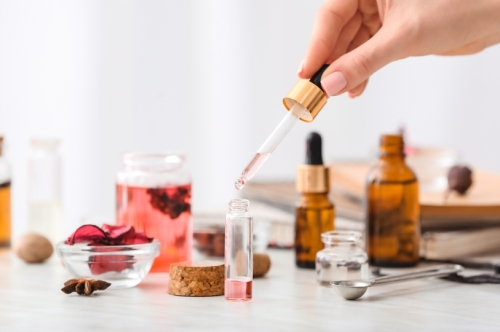Best Essential Oils for Sleep: 7 Natural Ways to Beat Insomnia

With over 70 million Americans struggling with sleep disorders, the demand for natural sleep solutions continues to grow exponentially. Essential oils have emerged as one of the most effective and scientifically-backed natural remedies for improving sleep quality and reducing insomnia symptoms.
As manufacturers in the essential oils industry, we understand that not all oils deliver the same therapeutic benefits. The effectiveness of sleep-promoting aromatherapy depends heavily on oil purity, extraction methods, and proper application techniques. Through extensive research and quality testing protocols, certain essential oils have consistently demonstrated superior results for sleep enhancement.
This comprehensive guide examines the most effective essential oils for sleep support, their mechanisms of action, and practical application methods that maximize therapeutic benefits while ensuring user safety.
What Essential Oils Actually Help You Sleep Better?
Quick Answer: Lavender, chamomile, bergamot, cedarwood, and ylang ylang are the most effective essential oils for sleep, with lavender being the most scientifically proven.
The most therapeutically effective essential oils for sleep contain specific aromatic compounds that interact with neurotransmitter pathways to reduce cortisol levels and promote natural drowsiness. Quality and purity play crucial roles in determining effectiveness.
Lavender: The Research-Backed Sleep Champion
Lavender essential oil (Lavandula angustifolia) represents the gold standard in sleep aromatherapy, supported by over 100 peer-reviewed studies. The oil's primary active compounds—linalool and linalyl acetate—enhance GABA (gamma-aminobutyric acid) activity in the brain, promoting natural relaxation without the side effects associated with synthetic sleep aids.
Clinical research from the University of Southampton demonstrated that participants exposed to lavender aromatherapy experienced 20% improved sleep quality and reduced sleep latency. The study, published in the Journal of Alternative and Complementary Medicine, showed that 79% of participants reported significant sleep improvements within two weeks of consistent use.
Key therapeutic compounds:
- Linalool (25-38% in high-quality oils)
- Linalyl acetate (25-45% in premium grades)
- Camphor (<0.5% in therapeutic varieties)
Roman Chamomile: The Gentle Nervous System Sedative
Roman chamomile (Chamaemelum nobile) contains apigenin, a flavonoid that binds to benzodiazepine receptors in the brain, producing mild sedative effects. Research published in Phytomedicine indicates that chamomile aromatherapy significantly increases glycine levels—an amino acid that functions as a natural neurotransmitter inhibitor.
This oil proves particularly effective for individuals whose sleep difficulties stem from anxiety, racing thoughts, or emotional stress. Its gentle nature makes it suitable for sensitive users and long-term application protocols.
Bergamot: The Stress-Reducing Citrus Anomaly
Bergamot (Citrus bergamia) differs from other citrus oils due to its high linalool content and unique terpene profile that produces calming rather than energizing effects. Clinical studies published in Phytotherapy Research demonstrate that bergamot aromatherapy measurably reduces cortisol levels and blood pressure in chronically stressed individuals.
Quality bergamot oil for sleep applications should be steam-distilled rather than cold-pressed to ensure optimal linalool preservation and minimize photosensitizing compounds.
Cedarwood: The Melatonin Production Enhancer
Cedarwood essential oil (Cedrus atlantica) naturally stimulates melatonin production through its high cedrol content. Japanese research demonstrates that cedrol produces significant sedative effects on the autonomic nervous system, making it particularly valuable for sleep maintenance rather than just sleep initiation.
This oil excels in applications where users experience frequent nighttime awakenings or early morning sleep disruption.
Ylang Ylang: The Cardiovascular Relaxant
Ylang ylang (Cananga odorata) contains sedative compounds that measurably reduce heart rate and blood pressure. Controlled studies published in the Journal of Health Research show that ylang ylang aromatherapy decreases psychological stress responses and promotes sustained evening relaxation.
Manufacturing quality considerations for ylang ylang include distillation grade (Extra, I, II, or III), with Extra and Grade I providing the most pronounced therapeutic effects for sleep applications.
Ylang Ylang Essential Oil Benefits
How Do Essential Oils Actually Work to Improve Sleep Quality?
Quick Answer: Essential oils work by affecting the limbic system in the brain, which controls emotions, memory, and physiological functions like heart rate and hormone production that directly impact sleep.
Essential oils influence sleep through multiple biological pathways, primarily by affecting the limbic system—the brain's emotional processing center that directly regulates areas controlling sleep, cardiovascular function, and hormone production.
Neurological Mechanisms of Action
When aromatic molecules from high-quality essential oils are inhaled, they travel through the olfactory system directly to the limbic brain within seconds. This pathway bypasses the blood-brain barrier, allowing therapeutic compounds to quickly influence neurotransmitter production and hormonal balance.
Primary mechanisms include:
GABA Enhancement: Sleep-promoting essential oils increase GABA (gamma-aminobutyric acid) activity, the brain's primary inhibitory neurotransmitter. Enhanced GABA function reduces neuronal excitability throughout the nervous system, creating the calm, relaxed state necessary for natural sleep onset.
Cortisol Suppression: Chronic stress and elevated cortisol levels represent major contributors to insomnia. Multiple clinical studies demonstrate that aromatherapy with lavender, bergamot, and chamomile significantly reduces cortisol production, helping interrupt the stress-insomnia cycle.
Melatonin Regulation: Certain essential oils, particularly cedarwood and sandalwood, support natural melatonin production without disrupting circadian rhythm regulation. Unlike synthetic melatonin supplements, these oils work synergistically with existing sleep-wake cycles.
Autonomic Nervous System Modulation: Therapeutic-grade essential oils facilitate the transition from sympathetic (fight-or-flight) to parasympathetic (rest-and-digest) nervous system dominance, which is essential for sleep preparation and maintenance.
Quality Impact on Therapeutic Effectiveness
The therapeutic effectiveness of essential oils for sleep directly correlates with oil purity, extraction methods, and storage conditions. Adulterated or poorly processed oils may lack sufficient concentrations of active compounds to produce measurable physiological effects.
Manufacturing quality factors that influence sleep effectiveness include:
- Extraction temperature and pressure parameters
- Plant material freshness and harvesting timing
- Storage conditions throughout the supply chain
- Absence of synthetic adulterants or carrier oil dilution
Which Essential Oil Works Best for Different Sleep Problems?
Quick Answer: Use lavender for general insomnia, cedarwood for staying asleep, bergamot for stress-related sleep issues, and chamomile for racing thoughts.
Different sleep disorders require targeted approaches using specific essential oils optimized for particular mechanisms of action. Understanding these applications helps maximize therapeutic outcomes.
Sleep Onset Difficulties (Trouble Falling Asleep)
For individuals who experience prolonged sleep latency:
Primary recommendations:
- Lavender + Roman chamomile blend (4:2 ratio)
- Bergamot for stress-induced sleep onset issues
- Ylang ylang for emotionally-triggered sleep difficulties
Mechanism: These oils primarily target anxiety reduction and mental quieting through GABA enhancement and cortisol suppression.
Sleep Maintenance Issues (Frequent Night Wakings)
For people who fall asleep easily but experience fragmented sleep:
Primary recommendations:
- Cedarwood + sandalwood combination (3:1 ratio)
- Vetiver for deep sleep phase enhancement
- Frankincense for sleep architecture stabilization
Mechanism: These grounding oils support sustained parasympathetic nervous system activity and natural melatonin regulation throughout the night.
Stress-Related Sleep Disruption
For sleep issues connected to work stress, anxiety, or life transitions:
Primary recommendations:
- Bergamot + lavender combination (2:3 ratio)
- Clary sage for hormonal stress (particularly effective for women)
- Sweet marjoram for tension-related sleep issues
Mechanism: These oils specifically target stress hormone regulation and emotional processing centers in the brain.
Early Morning Awakening Patterns
For individuals who wake too early and cannot return to sleep:
Primary recommendations:
- Roman chamomile + sandalwood blend
- Vetiver for circadian rhythm stabilization
- Cedarwood for extended sleep duration support
Mechanism: These oils help maintain natural sleep cycles and prevent premature cortisol elevation that triggers early awakening.
How Should You Use Essential Oils for Sleep?
Quick Answer: Diffuse 4-6 drops 30 minutes before bed, apply diluted oils to pulse points, or create a pillow spray. Never apply undiluted oils directly to skin.
Proper application methods significantly impact both safety and therapeutic effectiveness. Manufacturing guidelines recommend specific protocols based on oil concentration and individual sensitivity factors.
Aromatic Diffusion: The Primary Application Method
Ultrasonic diffusion provides the most consistent and controlled delivery method for sleep aromatherapy. Optimal protocols include:
Dosage guidelines:
- 4-6 drops total essential oil blend per standard diffuser
- Begin diffusion 30-60 minutes before intended sleep time
- Run continuously for 30-60 minutes, then allow natural shut-off
Quality considerations: Use only therapeutic-grade oils in diffusers, as synthetic fragrances or adulterated oils may cause respiratory irritation or reduced effectiveness.
Topical Application: For Enhanced Absorption
Proper dilution in carrier oils allows for both aromatic and potential transdermal benefits:
Safe dilution ratios:
- Adults: 2-3% dilution (12-18 drops per ounce of carrier oil)
- Sensitive individuals: 1% dilution (6 drops per ounce)
- Elderly users: 0.5-1% dilution (3-6 drops per ounce)
Recommended carrier oils: Jojoba, fractionated coconut oil, and sweet almond oil provide optimal absorption without interfering with essential oil therapeutic properties.
Application sites: Pulse points (wrists, temples), behind ears, or soles of feet for systemic absorption.
Linen and Pillow Spray Applications
DIY sleep sprays offer convenient, controlled application:
Basic formulation:
- 15-20 drops sleep-promoting essential oil blend
- 2 ounces distilled water
- 1 teaspoon witch hazel (emulsifier)
- Combine in glass spray bottle, shake before each use
Application timing: Spray bedding 10-15 minutes before lying down to allow alcohol evaporation while maintaining aromatic benefits.
Bath Aromatherapy Integration
Combining essential oils with warm water creates synergistic relaxation effects:
Protocol:
- Add 5-8 drops essential oils to Epsom salts first
- Dissolve salt mixture in warm bath (98-102°F)
- Soak for 15-20 minutes, 1-2 hours before intended sleep time
Are Essential Oils Safe to Use Every Night for Sleep?
Quick Answer: High-quality, properly diluted essential oils are generally safe for nightly use when following proper guidelines, but pregnant women, children, and people with certain health conditions should use extra caution.
Safety considerations for regular essential oil use depend on oil quality, application methods, individual health status, and proper dilution protocols. Manufacturing standards and purity testing play crucial roles in long-term safety profiles.
General Safety Parameters for Nightly Use
Quality requirements:
- Use only therapeutic-grade oils from verified suppliers
- Ensure GC/MS testing confirms purity and composition
- Store oils properly to prevent oxidation and contamination
- Replace oils showing signs of degradation (color change, off-odors)
Application safety:
- Always dilute topical applications appropriately
- Maintain adequate ventilation during diffusion
- Start with lower concentrations and shorter exposure times
- Take occasional breaks to prevent potential sensitization
Special Population Considerations
Pregnancy and nursing: Hormonal changes affect essential oil metabolism. Recommended protocols include:
- Use only mild oils like lavender and chamomile
- Reduce normal dilution rates by 50%
- Avoid stimulating oils (rosemary, sage, peppermint)
- Consult healthcare providers before beginning use
Pediatric applications: Children process essential oils differently than adults:
- Ages 6-12: Use only gentle oils at 0.5% dilution
- Under age 6: Consult pediatric healthcare providers
- Never use eucalyptus, peppermint, or wintergreen on young children
Respiratory conditions: Individuals with asthma, COPD, or chemical sensitivities should:
- Start with very minimal diffusion amounts
- Ensure excellent room ventilation
- Discontinue use if breathing difficulties occur
- Consider patch testing before any application
Drug Interaction Considerations
Essential oils can potentially interact with certain medications:
Blood-thinning medications: Wintergreen and birch oils contain natural salicylates Blood pressure medications: Some oils may enhance hypotensive effects Central nervous system depressants: May amplify sedative effects Diabetes medications: Certain oils can affect blood glucose levels
Quality Assurance and Sourcing
The safety profile of essential oils directly relates to manufacturing quality and purity. When sourcing oils for therapeutic use, verification of supplier credentials and testing protocols becomes essential. Some users have found reliable suppliers through platforms like norex.in when seeking authenticated products, though thorough quality verification remains important regardless of source.
Key quality indicators:
- Batch-specific GC/MS reports available
- Proper botanical nomenclature on labeling
- Appropriate storage in dark glass containers
- Realistic pricing that reflects extraction costs
- Supplier transparency about sourcing and processing
Do Essential Oils Work Better Than Sleep Medications?
Quick Answer: Essential oils aren't stronger than prescription sleep aids, but they're gentler, non-addictive, and work well for mild to moderate sleep issues without side effects.
Essential oils and pharmaceutical sleep aids work through different mechanisms and serve different therapeutic roles. Understanding these differences helps determine appropriate applications for various sleep disorder severities.
Comparative Effectiveness Profiles
Essential oil advantages:
- No tolerance development or dependence potential
- Preserve natural sleep architecture
- Minimal to no side effects when used properly
- Can be used long-term without medical supervision
- Support overall wellness beyond sleep improvement
- Cost-effective for ongoing use
Pharmaceutical advantages:
- More potent for severe insomnia cases
- Standardized dosing and predictable effects
- Faster onset of action for acute sleep crises
- Medical supervision available for complex cases
- Extensive clinical trial data for efficacy
Research-Based Effectiveness Comparisons
Clinical studies indicate that high-quality lavender aromatherapy can improve sleep quality by approximately 20%, while pharmaceutical sleep aids typically show 40-60% improvement in sleep metrics. However, essential oils maintain effectiveness over time without tolerance development.
A 2019 meta-analysis published in Sleep Medicine Reviews found that:
- Essential oils showed sustained benefits over 8-12 week periods
- Pharmaceutical aids often lost effectiveness after 2-4 weeks of regular use
- Combined approaches (essential oils + sleep hygiene) produced optimal outcomes
- Side effect profiles favored essential oil interventions significantly
Appropriate Application Guidelines
Essential oils work best for:
- Mild to moderate sleep difficulties
- Stress or anxiety-related sleep issues
- Supporting healthy sleep hygiene practices
- Long-term sleep quality enhancement
- Individuals seeking non-pharmaceutical approaches
Medical intervention may be necessary for:
- Severe, chronic insomnia lasting more than 4 weeks
- Sleep disorders related to underlying medical conditions
- Cases where natural interventions haven't provided adequate relief
- Situations requiring immediate, potent intervention
What's the Best Essential Oil Blend for Deep Sleep?
Quick Answer: A blend of 4 drops lavender, 2 drops cedarwood, and 1 drop Roman chamomile creates an effective deep sleep combination that addresses both falling asleep and staying asleep.
Synergistic blending maximizes therapeutic benefits by combining oils with complementary mechanisms of action. Professional formulations target multiple aspects of sleep physiology simultaneously.
Scientifically-Formulated Sleep Blends
"Deep Sleep" Professional Blend:
- 40% Lavender (Lavandula angustifolia)
- 30% Cedarwood (Cedrus atlantica)
- 20% Roman Chamomile (Chamaemelum nobile)
- 10% Sandalwood (Santalum album)
Mechanism: This combination targets sleep onset (lavender, chamomile), sleep maintenance (cedarwood), and deep sleep phases (sandalwood).
"Stress Relief" Evening Blend:
- 35% Bergamot (Citrus bergamia)
- 35% Lavender (Lavandula angustifolia)
- 20% Ylang Ylang (Cananga odorata)
- 10% Sweet Marjoram (Origanum majorana)
Mechanism: Specifically formulated for stress-induced sleep difficulties, targeting cortisol reduction and emotional regulation.
"Sleep Maintenance" Blend:
- 40% Cedarwood (Cedrus atlantica)
- 30% Vetiver (Vetiveria zizanioides)
- 20% Sandalwood (Santalum album)
- 10% Frankincense (Boswellia carterii)
Mechanism: Designed for individuals who fall asleep easily but experience frequent nighttime awakenings.
Formulation Principles for Effective Blends
Synergistic compound selection: Combine oils with complementary terpene profiles that enhance rather than compete with each other's therapeutic actions.
Concentration ratios: Base oils (40-50% of blend) provide primary therapeutic action, while modifier oils (10-20% each) enhance specific aspects of the formula.
Quality considerations: Blend effectiveness depends on using oils with verified therapeutic compound concentrations. Adulterated or poor-quality oils can disrupt synergistic interactions.
Custom Blending Guidelines
Single-oil testing: Evaluate individual response to each oil before creating complex blends.
Gradual complexity: Start with 2-oil combinations before progressing to more complex formulations.
Documentation: Track blend ratios and effectiveness to optimize personal formulations.
Seasonal adjustments: Modify blends based on seasonal factors, stress levels, and changing sleep patterns.
How Long Does It Take for Essential Oils to Work for Sleep?
Quick Answer: Most people notice some improvement within a few days, but it typically takes 2-3 weeks of consistent use to see the full benefits of essential oils for sleep.
Essential oil effectiveness for sleep follows predictable timelines that correlate with neuroplasticity and circadian rhythm adaptation. Understanding these patterns helps set realistic expectations and optimize protocols.
Progressive Effectiveness Timeline
Days 1-3: Initial Response Phase
- Immediate aromatic pleasure and relaxation response
- Possible mild improvement in sleep onset time
- Beginning of scent-sleep association formation
- Individual sensitivity variations become apparent
Week 1: Adaptation Phase
- More consistent relaxation response to aromatherapy
- Slight improvements in overall sleep quality
- Establishment of routine and timing protocols
- Potential need for dosage or method adjustments
Weeks 2-3: Integration Phase
- Noticeable improvement in sleep onset and maintenance
- Enhanced overall sleep quality and morning freshness
- Stronger psychological associations with sleep cues
- Optimal dosing and application methods established
Month 2+: Optimization Phase
- Maximum therapeutic benefits achieved
- Sustainable sleep pattern improvements
- Potential for reduced reliance on other sleep aids
- Long-term sleep architecture enhancement
Factors Affecting Response Timeline
Oil quality and purity: Therapeutic-grade oils with verified compound concentrations produce faster, more consistent results than adulterated or synthetic alternatives.
Application consistency: Regular, nightly use accelerates benefit timeline compared to sporadic application.
Individual biochemistry: Genetic variations in scent sensitivity and neurotransmitter metabolism affect response speed.
Baseline sleep quality: People with mild sleep issues typically see faster improvement than those with severe, chronic insomnia.
Concurrent interventions: Combining essential oils with improved sleep hygiene practices accelerates overall benefits.
Optimizing Response Timeline
Consistency protocols: Use oils at the same time each evening to strengthen circadian rhythm associations.
Quality verification: Ensure oils meet therapeutic standards through GC/MS testing or certified supplier verification.
Method optimization: Experiment with different application methods to find most effective delivery for individual circumstances.
Documentation: Track sleep quality metrics to identify optimal oils, dosages, and timing.
Where Can You Find High-Quality Essential Oils for Sleep?
Quick Answer: Buy from companies that provide GC/MS testing reports, use proper botanical names, and specialize in therapeutic aromatherapy rather than general retail stores.
The therapeutic effectiveness of essential oils for sleep depends critically on oil purity, extraction methods, and storage conditions. Understanding quality indicators helps identify suppliers that provide genuine therapeutic benefits.
Quality Authentication Standards
Essential documentation:
- Batch-specific GC/MS (Gas Chromatography-Mass Spectrometry) reports
- Complete botanical nomenclature (Lavandula angustifolia, not generic "lavender")
- Extraction method specifications (steam distillation, CO2, etc.)
- Country of origin and harvest date information
- Organic certification when applicable
Red flag indicators:
- Uniform pricing across all oils regardless of rarity
- "Therapeutic grade" marketing claims (no legal definition exists)
- Lack of testing documentation availability
- Storage in clear glass or plastic containers
- Vague or missing extraction method information
Supplier Evaluation Criteria
Professional aromatherapy suppliers: Companies serving certified practitioners typically maintain higher quality standards and provide comprehensive technical documentation.
Manufacturing transparency: Reliable suppliers disclose relationships with distillers, extraction parameters, and quality control procedures.
Storage and handling: Professional suppliers maintain proper temperature control, light protection, and inventory rotation to preserve oil integrity.
Technical support: Quality suppliers provide detailed usage guidelines, safety information, and application protocols.
Market Considerations and Sourcing
The essential oils market includes numerous suppliers with varying quality standards. Some procurement professionals have found reliable sources through specialized platforms like norex.in when sourcing for commercial applications, though thorough quality verification remains essential regardless of supplier choice.
Verification protocols:
- Request current batch GC/MS reports for critical oils
- Verify supplier certifications and industry affiliations
- Compare pricing with industry standards (extremely low prices indicate likely adulteration)
- Evaluate packaging, labeling, and storage condition evidence
Long-term supplier relationships: Developing relationships with verified suppliers ensures consistent quality and access to limited-availability oils.
Storage and Handling Best Practices
Optimal storage conditions:
- Temperature: 60-70°F (15-21°C) consistently
- Light protection: Dark glass containers, stored away from direct light
- Air exposure: Minimize headspace in bottles, use quickly after opening
- Contamination prevention: Clean tools, proper cap replacement
Quality monitoring:
- Regular sensory evaluation for changes in aroma or appearance
- Documentation of purchase dates and expected shelf life
- Proper disposal of oxidized or degraded oils
- Rotation of inventory to use oldest oils first
Can You Use Essential Oils for Sleep if You Have Allergies?
Quick Answer: Yes, but start with patch testing and choose hypoallergenic oils like lavender or chamomile. Avoid oils from plants you're already allergic to.
Essential oil use for individuals with allergies or chemical sensitivities requires careful selection and testing protocols. Understanding allergen profiles and implementing proper testing procedures enables safe therapeutic use.
Hypoallergenic Essential Oil Options
Generally well-tolerated oils for sensitive individuals:
- Lavender (Lavandula angustifolia): Lowest allergen potential among sleep oils
- Roman Chamomile (Chamaemelum nobile): Gentle profile, rarely causes reactions
- Sandalwood (Santalum album): Minimal sensitization risk when pure
- Frankincense (Boswellia carterii): Low allergen profile, anti-inflammatory properties
Oils requiring extra caution:
- Ylang Ylang: Occasionally triggers headaches in sensitive individuals
- Bergamot: Contains potential photosensitizing compounds
- Tea Tree: Higher sensitization potential with repeated use
Allergy Assessment Protocols
Cross-reactivity evaluation: Individuals allergic to specific plant families should avoid essential oils from related plants:
- Asteraceae family allergies: Avoid chamomile, calendula oils
- Citrus allergies: Approach bergamot and sweet orange with extreme caution
- Grass allergies: Use caution with lemongrass and related oils
Patch testing procedures:
- Dilute test oil to 0.5% in carrier oil (3 drops per teaspoon)
- Apply small amount to inner forearm
- Cover with non-reactive bandage for 24-48 hours
- Monitor for redness, itching, swelling, or irritation
- If any reaction occurs, wash immediately and avoid that oil
Safe Implementation for Sensitive Users
Gradual introduction protocol:
- Start with single oils rather than blends
- Use lower concentrations than standard recommendations
- Begin with shorter exposure times (15-20 minutes diffusion)
- Monitor for delayed reactions over several days
Environmental considerations:
- Ensure excellent room ventilation during use
- Start with daytime testing before nighttime application
- Keep antihistamines available during initial testing phases
- Document all reactions for future reference
Professional consultation: Individuals with severe allergies or multiple chemical sensitivities should consult allergists or qualified aromatherapists before beginning essential oil protocols.
Summary: Creating Your Optimal Sleep Aromatherapy Routine
Essential oils offer a scientifically-supported, natural approach to improving sleep quality when used correctly with high-quality, therapeutic-grade products. Success depends on understanding individual sleep challenges, selecting appropriate oils based on their specific mechanisms of action, and implementing consistent application protocols.
The most effective approach combines proven sleep-promoting oils like lavender, chamomile, and cedarwood with proper dilution methods, quality sourcing, and safety considerations. Whether addressing occasional sleeplessness or chronic insomnia patterns, essential oils can provide valuable support as part of comprehensive sleep hygiene practices.
Quality remains paramount in achieving therapeutic benefits. Investing in verified, pure essential oils from reputable suppliers ensures both safety and effectiveness while maximizing the natural sleep-promoting potential of aromatherapy.
For optimal results, start with simple, well-researched oils, maintain consistent application timing, and allow 2-3 weeks for full benefits to develop. With proper use, essential oils can become a valuable, sustainable tool for achieving better sleep naturally.












